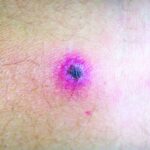Rickettsial infection refers to a group of zoonotic diseases caused by obligate intracellular Gram-negative bacteria of the genus Rickettsia and related organisms. These pathogens are primarily transmitted to humans through vectors such as ticks, fleas, lice, and mites. The diseases can range from mild febrile illnesses to severe, life-threatening conditions.

Classification and Types of Rickettsial Infections
Rickettsial infections are broadly categorized into the following groups based on the causative species and clinical features:
1. Spotted Fever Group (SFG)
- Examples: Rocky Mountain spotted fever (Rickettsia rickettsii), Mediterranean spotted fever
- Vector: Hard ticks
- Key Feature: Maculopapular rash progressing to petechiae
2. Typhus Group
- Epidemic Typhus: Caused by Rickettsia prowazekii, transmitted by body lice
- Endemic (Murine) Typhus: Caused by Rickettsia typhi, spread by fleas
3. Scrub Typhus
- Caused by Orientia tsutsugamushi
- Transmitted by larval trombiculid mites (chiggers)
- Prevalent in the Asia-Pacific region
4. Transitional Group
- Includes emerging species such as Rickettsia felis
Pathogenesis of Rickettsial Diseases
Rickettsial organisms invade and replicate within endothelial cells lining the blood vessels. This leads to:
- Vascular inflammation (vasculitis)
- Increased vascular permeability
- Microvascular leakage
- Thrombosis and organ dysfunction in severe cases
The incubation period generally ranges from 5 to 14 days, after which systemic symptoms begin to manifest.
Clinical Presentation: Signs and Symptoms
The clinical features vary depending on the rickettsial species but commonly include:
| Symptom | Description |
|---|---|
| Fever | High-grade, sudden-onset |
| Headache | Severe, often retro-orbital |
| Rash | Maculopapular or petechial, usually begins on extremities |
| Myalgia | Generalized body aches |
| Eschar | Necrotic lesion at bite site (common in scrub typhus) |
| Lymphadenopathy | Regional swelling of lymph nodes |
| Gastrointestinal | Nausea, vomiting, abdominal pain |
| Neurological | Delirium, meningismus in severe cases |
Diagnostic Approach to Rickettsial Infection
Clinical Diagnosis
Initial diagnosis is typically based on:
- Epidemiological history (e.g., recent travel, exposure to ticks or rodents)
- Presence of eschar or rash
- Sudden onset of fever with systemic symptoms
Laboratory Tests
| Test | Purpose |
|---|---|
| Complete blood count | May show thrombocytopenia and leukopenia |
| Liver function tests | Elevated transaminases |
| Weil-Felix test | Non-specific, outdated but still used in some settings |
| Indirect immunofluorescence (IFA) | Gold standard for serological diagnosis |
| Polymerase Chain Reaction (PCR) | Detects rickettsial DNA in blood or tissue |
| Skin biopsy (rash site) | Confirms diagnosis via immunohistochemistry |
Treatment and Management of Rickettsial Infections
First-Line Therapy
- Doxycycline: The antibiotic of choice for all rickettsial infections
- Adults: 100 mg twice daily
- Children: Safe for short-course use despite prior concerns regarding teeth discoloration
Alternative Treatments
- Chloramphenicol: For pregnant women or those with doxycycline contraindications
- Azithromycin: May be used in mild cases or as an alternative in pediatric patients
Supportive Care
- Hydration
- Antipyretics for fever
- Monitoring for complications such as hypotension or renal failure
Complications and Severe Manifestations
If untreated, rickettsial infections can lead to life-threatening outcomes:
- Disseminated intravascular coagulation (DIC)
- Acute respiratory distress syndrome (ARDS)
- Encephalitis
- Hepatorenal failure
- Septic shock
Early initiation of doxycycline significantly reduces mortality and morbidity.
Prevention and Public Health Measures
Vector Control Strategies
- Use of insect repellents (DEET-based)
- Wearing protective clothing in endemic regions
- Regular tick checks after outdoor activities
- Rodent control to minimize flea and louse exposure
Chemoprophylaxis
- Not routinely recommended
- May be considered for high-risk exposure under medical advice
Vaccination
- Currently, no approved vaccine for human use exists
- Research into vaccines for R. prowazekii and O. tsutsugamushi is ongoing
Global Epidemiology and Distribution
| Region | Common Rickettsial Disease |
|---|---|
| United States | Rocky Mountain spotted fever |
| Southern Europe | Mediterranean spotted fever |
| Southeast Asia | Scrub typhus |
| Central and South America | Murine typhus |
| Africa | African tick bite fever |
Rickettsial diseases are considered neglected in many parts of the world due to limited diagnostic facilities and low clinical suspicion.
Rickettsial infections represent a significant yet often overlooked cause of febrile illness, especially in tropical and subtropical regions. Prompt recognition, accurate diagnosis, and early initiation of appropriate antibiotic therapy are essential to prevent complications and reduce mortality. With growing global mobility and climate change influencing vector behavior, rickettsial infections may continue to emerge as public health threats requiring increased awareness and surveillance.

